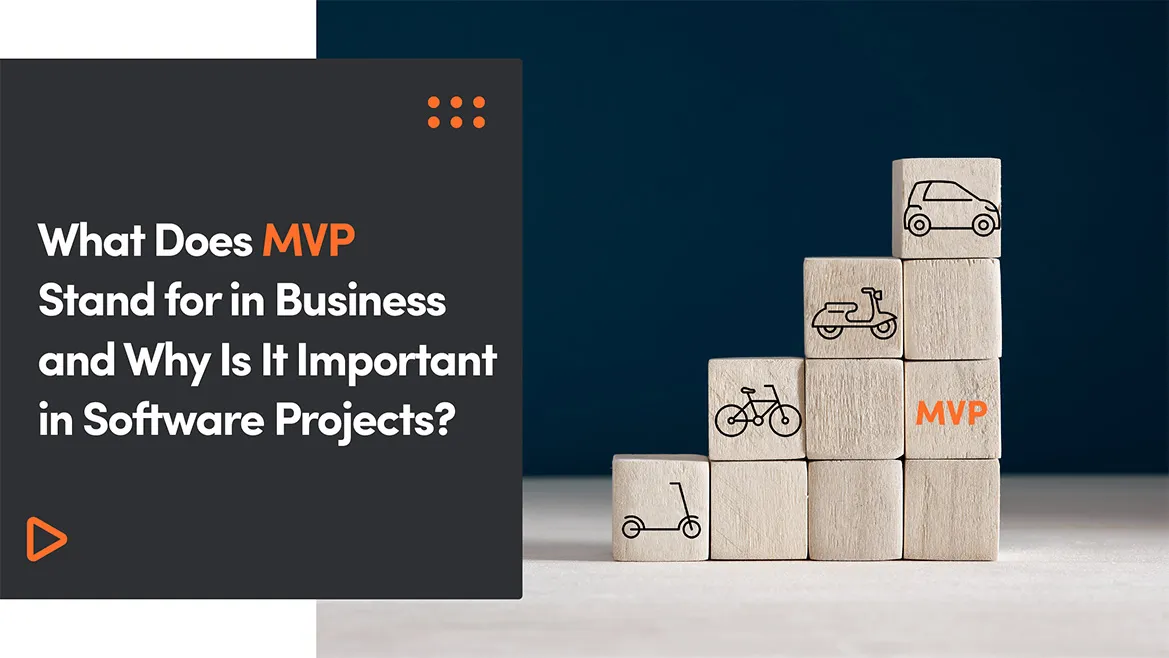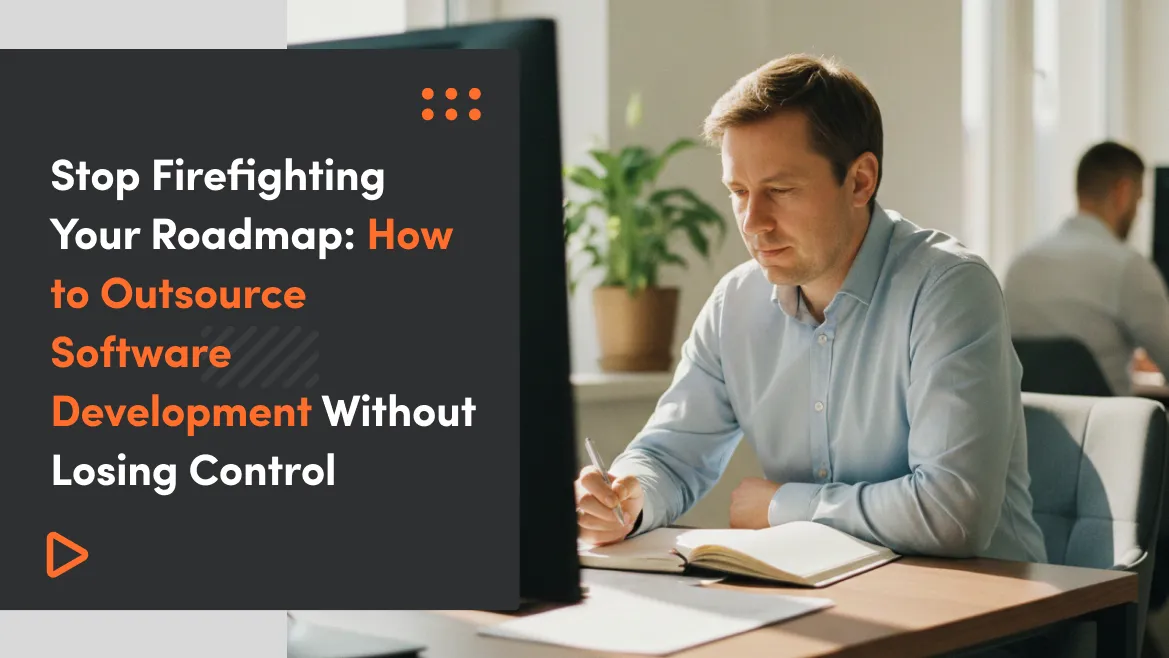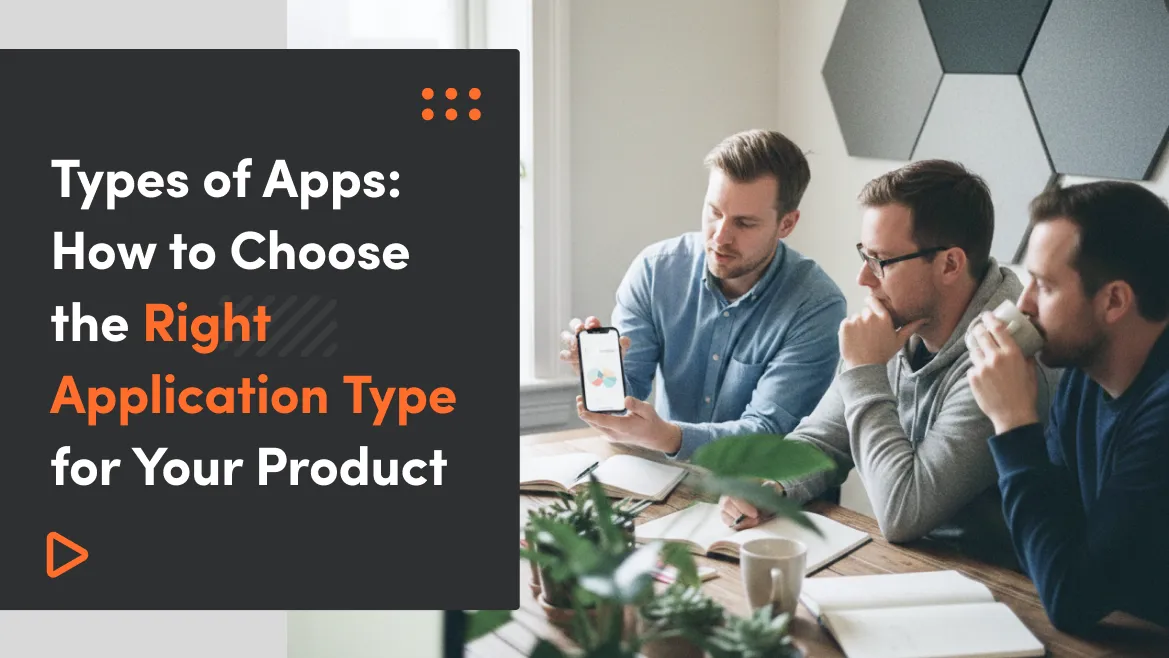First of all, what is MVP? The Minimum Viable Product strategy has gained widespread popularity among both startups and established businesses seeking efficient business validation. At its essence, the MVP approach advocates for a streamlined and strategic process, emphasizing the development of a product with the minimum set of features necessary to satisfy early adopters and gather valuable feedback. Early adopters often offer invaluable insights into what works and what doesn’t. In the perfect scenario, early adopters are our first clients, which helps us to shape the marketable product MMP (Minimum Marketable Product).
The primary objective of adopting the MVP approach is to quickly bring a functional version of the product to market, allowing companies to test their hypotheses, validate their ideas, and gather crucial insights from real users. By concentrating on the core features and functionality that define the product's essence, businesses can accelerate the development cycle and engage with their target audience in a meaningful way.
In doing so, companies can efficiently allocate resources, mitigate risks, and adapt their product based on user feedback, ultimately steering their efforts toward achieving product-market fit.
For example, Dropbox started with a basic MVP - a demo video showcasing its core features. The video created huge interest and sign-ups for the beta version, confirming a strong demand. Surpassing expectations, the waiting list skyrocketed from 5,000 to 75,000 overnight. By 2022, Dropbox had 17.77 million paid users and made $2.33 billion in annual revenue.
What you will learn from this article:
- How MVP can help validate your business idea?
- What are the pros and cons of MVP approach?
- I want MVP - where to start?
- 6 key things to remember when looking a software team for MVP development
- How to build mobile and web MVP - case study
- Will your business fail if you don't start with MVP?
- What happens after the MVP release?
What Does MVP Stand for in Business and How Can it Help You Validate Your Business Idea?
MVP stands for Minimum Viable Product. It’s a strategic approach in both business and software development that emphasizes the creation of a simplified version of a product with the primary aim of swiftly bringing it to market. This lean methodology enables businesses to test their concepts and assumptions, gather valuable user feedback, and iteratively refine the product based on real-world usage. In essence, an MVP is the first tangible representation of a concept or idea, allowing businesses and development teams to validate their hypotheses with minimal investment.
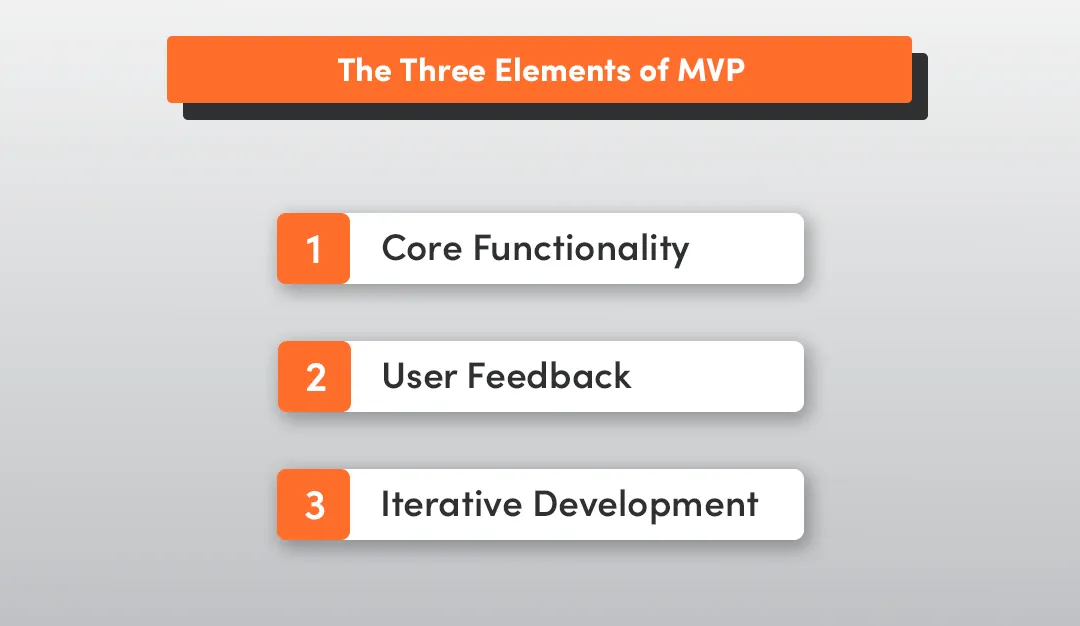
The Three Elements of MVP
Core functionality - includes only the essential features that address the primary needs of the target audience. It's about delivering the core value proposition without any extras or bells and whistles.
User feedback - given by real users. Collecting feedback and insights from these early adopters is fundamental. This feedback loop helps in understanding user preferences, pain points, and expectations, which in turn guides further development.
Iterative Development - it's not a one-time launch. Rather, it involves a cycle of continuous improvement based on user feedback and market response. Each iteration refines the product further.
When the product team creates an MVP, they begin by grasping the client's goals, vision, and audience needs. Clear insights here are crucial for an MVP that aligns with the client's objectives. Then, the team pinpoints the must-have features based on market analysis and client requirements, ensuring the MVP's viability. Using iterative methods (i.e. agile), they swiftly build a basic, functional version of the product, prioritizing speed and efficiency. This initial model undergoes testing among specific user groups, enabling the team to gather feedback and spot areas for improvement. They continuously refine the MVP based on this feedback, adding features or enhancing existing ones until the product evolves into a more polished, market-ready version.
Well-defined MVP = Cost-effectiveness
Why is MVP Important for Startup Projects
MVP plays a pivotal role in the early phases of software development for the business, providing a strategic approach that emphasizes cost-effectiveness. The concept of MVP revolves around delivering a only basic version of a product with just enough features to satisfy initial users. This approach not only accelerates the development process but also mitigates risks and facilitates valuable user input.
The cost-effectiveness of MVP lies in its ability to optimize resource allocation, reduce time-to-market, and enhance the overall efficiency of the development cycle.
Moreover, usually, the general role of MVP is to build a proof that the concept works and brings value to end-users, so product owners can take the prototype to the market and look for a broader audience. It could be i.e. for stakeholders if the product supports internal processes or for venture capital investors - to reduce their risks of not delivering the real value.
By focusing on the essential features that address the core needs of users, an experienced product team can significantly reduce the time and resources invested in the initial stages. This approach prevents unnecessary expenditure on elaborate features that may not align with user expectations. The early release of a functional product allows startups to gauge market interest, validate assumptions, and make informed decisions for subsequent iterations.
This iterative process minimizes the risk of investing heavily in a product that may not meet user demands or market trends.
MVP for Startups
MVP development for startups shares similarities with larger businesses, differing mainly in scope and budget. To save time and money, startup founders without a professional team might choose to outsource MVP development rather than hiring in-house. Some discovery stage steps could be skipped, especially if founders have a unique idea or a refined prototype, potentially reducing costs further.
What’s great about MVP is that depending on the idea, you can validate the concept from days to a few months, without burning out the whole possible budget. Savings can be spent on marketing and sales activities that will determine the product-market fit as well as business usefulness.Startup founders, whether they have a rough product draft or a detailed prototype, can engage an MVP development company, particularly offshore ones, to compensate for experience gaps.
These companies guide the MVP process, breaking it into stages, explaining each step, and offering specialized experts for continued product work. Ultimately, every startup is different, so founders benefit from comparing multiple MVP development companies to find the best fit in terms of pricing and talent.
Try our developers.
Free for 2 weeks.
No risk. Just results. Get a feel for our process, speed, and quality — work with our developers for a trial sprint and see why global companies choose Selleo.
MVP Pros and Cons
When deciding whether to implement an MVP strategy, it's crucial to weigh the potential pros and cons based on the specific context and goals of your business model. The decision should align with your overall product development and market entry strategy.
As Marc Andreessen founder of Netscape and general partner of Silicon Valley venture capital once said:
The only thing that matters is getting to product-market-fit
This is your goal - no matter what, but there are some caveats to keep in the back of your head because MVP It's not all sunshine and roses.
MVP Pros:
- Accelerated market entry
- Efficient market validation
- Product refinement based on consumer feedback
- Cost and time savings
- Agile and quick product iterations
- Early insight into public acceptance
- Identification of potential buyers through prototypes
- Swift product development aligned with user expectation
MVP Cons:
- The continuous need for customer feedback
- Competitors' ability to enhance and release similar products faster (time is the most critical in this game!)
- Possibility of unexpected delays in development
The Minimum Viable Product approach offers numerous advantages, including swift market entry, validation, iterative improvements based on feedback, and cost savings. However, challenges such as the continual need for customer feedback, and potential competition risks, including idea theft and faster product releases, highlight the inherent complexities of this approach. Balancing these pros and cons is crucial for leveraging the benefits while mitigating the challenges of MVP implementation.
Because usually, we build MVP in the area that has some dose of unknown, there might be some hidden challenges on our way - that will try to slow us down, but in general - the most important factor is time.
How to Develop a Successful MVP in Software Development - Stages of Development
Developing a successful product requires careful planning, adherence to MVP principles, and a strategic approach to minimize costs and efforts. The MVP software development process typically involves several stages, each playing a crucial role in transforming an idea into a viable product.
From this article, you will find out how to build an MVP - Is it possible for 10k?
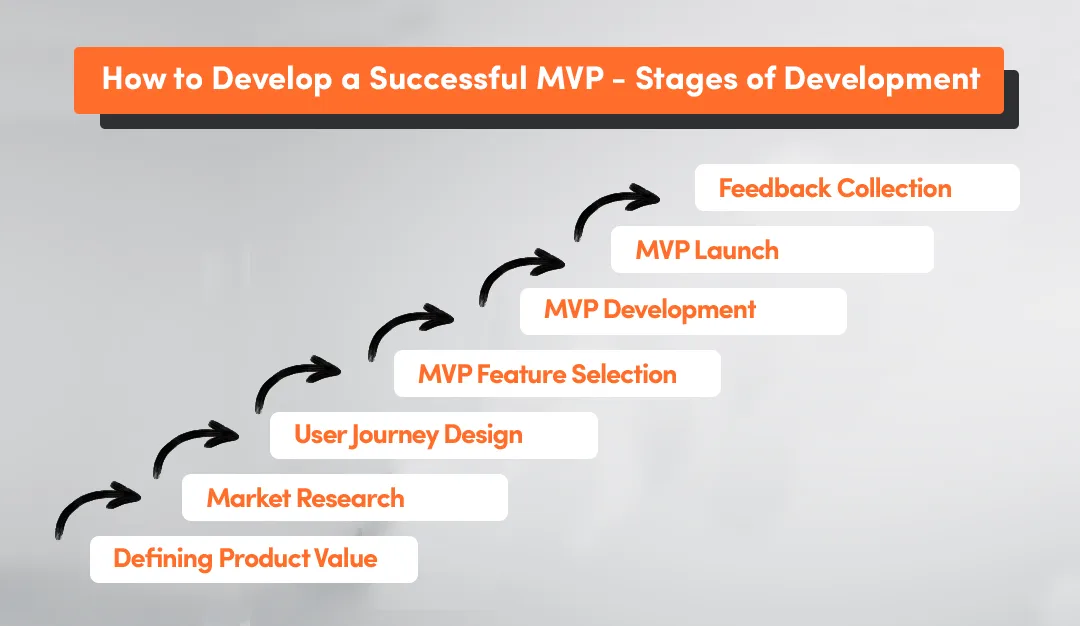
Defining Product Value
Clearly articulate the problem your software aims to solve and the unique value it brings to users. This involves understanding your target audience, their pain points, and how your product addresses those pain points better than existing solutions. Develop a clear and concise vision for your MVP, focusing on core features that directly contribute to solving the identified problem. This foundational step sets the direction for the entire development process and ensures that the end product aligns with user needs and expectations.
Some examples of well-known B2B players that defined their mission & product value:
Pipedrive is the easy and effective CRM for small and medium-sized companies.
PipeDrive
Make people's working lives simpler, more pleasant and more productive.
Slack
Our mission is to organize the world's information and make it universally accessible and useful.
Market Research
Conduct thorough market research to validate and refine your product concept. Analyze competitors, identify trends, and assess the demand for your solution. Engage with your target audience through surveys, interviews, or beta testing to gather valuable insights. This research not only validates your product idea but also helps you understand user preferences and expectations. Use this information to make informed decisions about your MVP's features and functionalities, ensuring that they align with market needs and stand out in a crowded landscape.
Make sure, you focus on delivering the most concerning features first, so you are able to validate something that brings value as soon as possible. Make sure, you are not copying 1:1 solutions from your competitors, because that doesn’t give you any advantage - innovation gives you an extra mile that can differentiate you from your competitors and win the customer's attention.
User Journey Design
Map out the user journey to understand how users will interact with your MVP. Define user personas and create user stories to outline the steps users will take to achieve their goals. Pay close attention to user experience (UX) design, ensuring that the user interface is intuitive. This step is critical for identifying potential friction points and optimizing the user flow. By mapping out the user journey, you can refine the design and functionality of your MVP to provide a seamless and enjoyable experience for your target audience.
However, don’t optimize over and over in this step when the most important thing you should do is to validate your idea with the market. Remember - time is the most critical factor.
MVP Feature Selection
Carefully select features for your MVP based on the insights gathered from market research and user journey mapping. Prioritize core functionalities that directly address the identified problem and deliver the most value to users. Avoid feature bloat by focusing on essentials that showcase your product's unique selling points. Keep in mind that the goal of the MVP is to validate your concept with minimal development effort, so prioritize all features that provide maximum impact with the least complexity.
Common examples of features that could postpone the initial validation in the SaaS applications are payments. Of course, it doesn’t mean you shouldn’t think about the commercial part, but to test the real value and engagement of the users, in most cases, you don’t need to develop payment-related features (with some exceptions).
MVP Development
With a clear roadmap and feature set, proceed to the development phase. Break down the development process into iterative sprints, allowing for continuous testing and refinement. Agile development methodologies work well for MVP projects, enabling flexibility and responsiveness to changing requirements. As you build the MVP, maintain a balance between speed and quality, ensuring that the product remains viable for early testing while meeting basic quality and security standards. Make sure that each development step is testable and brings extra value that you can use to attract your early testers.
MVP Launch
Launch your MVP to a select group of early adopters or a specific target audience. This controlled release allows you to gather real-world feedback and observe how users interact with your product. Choose appropriate channels for distribution, whether it's a private beta, a soft launch, or a limited release to a specific market. Clearly communicate that this is an initial release and actively encourage user feedback. This stage is about validating assumptions, refining features, and preparing for a broader release based on the insights gained.
Think about this step ahead to kick-start and then launch - when the MVP is ready. The most important part here is to get to the target customers - make sure you have such a target audience group ready to use your software and keep them engaged with the product. One of the most important support you can give to your future users here is the great onboarding experience - together with you for instance on the setup call. Make it as enjoyable as possible.
Feedback Collection
Actively collect and analyze feedback from users during and after the MVP launch. Use feedback loops to identify areas for improvement, understand user pain points, and validate your product's value proposition. Regularly iterate on the MVP based on this feedback, addressing critical issues and optimizing features. Establish communication channels for users to report bugs, suggest enhancements, and share their overall experience. The continuous feedback loop is vital for refining your product, enhancing customer satisfaction, and preparing for the next stages of development and scaling.
Don't be afraid to ask users, even directly, how they like your solution. Look at their real usage of the application - data is your ally and the most honest judge - measuring retention within your solution is the best factor of success.
6 Key Things to Remember When Looking for a Software Team For MVP Development
The success of your MVP development team hinges on their competence. Choosing the right talent ensures efficiency, innovation, and seamless execution, laying the groundwork for success. The following are six steps to help you find the best team in our opinion for your MVP development:
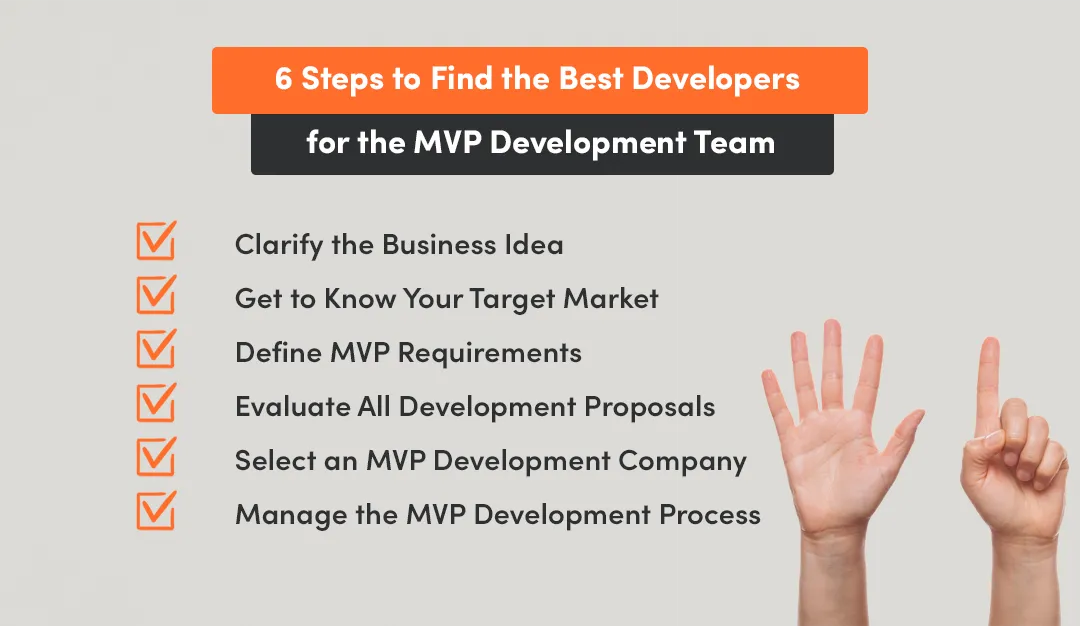
Clarify the Business Idea
Before you hire a team for your MVP, it's crucial to have a crystal-clear understanding of what you want to build. Many entrepreneurs rush into the staffing phase without a defined vision, but clarity at this stage is key. So, make a hard stop here for a moment.
Although development teams can assist in refining your vision, it's more cost-effective to be clear on your goals before contracting development. This initial step involves asking fundamental questions about your product, such as what you're bringing to the market, the desired final product appearance, insights from market research, and understanding your end user's needs. Building the right product is essential for longevity in a competitive market, regardless of the developers' skills. Find out why digital products fail.
If you have a team of your choice or a company that is willing to assist you in this journey - ask them to facilitate this process if you need so. Based on their experience, you can avoid some early traps and save some time.
Get to Know Your Target Market
Understand your target market to identify the specific features required for your MVP. Knowing your audience helps in selecting a team that has experience or a keen understanding of the market you're targeting. This step ensures that the developers can create a product tailored to your audience's needs and preferences.
Programming is not only about quality code but also a good understanding of the domain. Pick development teams that think of your business, not just typing.
Define MVP Requirements
Outline the specific features and functionalities your MVP must have. Clearly define the scope of the project, keeping in mind the core functionalities that will address the immediate needs of your target users.
Requirements generally fall into two categories - functional and technical. Anything you anticipate your users doing or anything you expect your software to accomplish should be outlined as requirements. It's important to define these explicitly without making assumptions.
This step is crucial for developers to provide accurate estimates and timelines for the MVP development.
Evaluate All Development Proposals
As you review the proposals from your shortlisted MVP development companies, focus on key aspects outlined in a software development proposal. Check their understanding of the problem to be solved, assessing the depth of comprehension. Look for detailed plans on how they propose to tackle the issue, emphasizing specificity in the services they intend to provide.
Additionally, evaluate the team members they plan to involve, ensuring their technical expertise aligns with your project's needs. Furthermore, consider the proposed schedule's alignment with your expectations and deadlines, along with how well the budget fits within your internal financial plan.
How to pick an MVP development company - checklist
- Review proposals
- Assess their comprehension of the problem
- Ask for a proposal on how to tackle the issue
- Evaluate the technical expertise of team members they offer
- Consider their offer compared to schedule and budgeting
Select an MVP Development Company
After evaluating your options, choose an MVP development company that aligns with your requirements, and ensure to gather input from all stakeholders before making a decision. Once you've made your selection, engage in negotiations and proceed to sign a contract with the chosen company.
During contract negotiations, consider factors such as terms, contract duration, pricing, and the delivery schedule. Schedule a meeting with the software development company to discuss the contract, clearly communicate your expectations, and inquire about the company's products and services. This meeting is a crucial opportunity to seek clarity on any points and negotiate changes if needed. After a thorough understanding and agreement, sign the software development contract and keep a copy for your records.
With the contract in place, you're now prepared for the kickoff of the development process.
Manage the MVP Development Process
Successfully developing an MVP hinges on effective project management. One crucial tip is to hire a project manager, either on your team or within the development team, to assist with all aspects of project planning and implementation. This ensures a structured approach to the development process.
It's essential to track progress using project management tools. These tools aid in identifying bottlenecks or issues that may arise during development. Furthermore, clarity on the timeline is paramount. Define a completion date for the MVP and work backward to establish milestones and deadlines, providing a clear roadmap for the development team to follow.
What Happens After the MVP Release?
The iterative nature of MVP development involves a continuous cycle of improvement that extends beyond minimal functionalities. As the product undergoes major updates, it evolves, necessitating a reevaluation of the vision, audience expansion, incorporating new features, enhancing existing ones, and the cultivation of strategic partnerships.
Throughout this iterative process, it's vital to uphold the foundational values that guide the product's creation. While evolving and adding features, maintaining consistency with the initial principles ensures coherence and trust among existing users.
The ultimate goal remains to create an "optimal" product by leveraging the insights gathered from the MVP stage. This approach saves resources by avoiding unnecessary features (as mentioned before) and instead focusing on elements that truly resonate with users, thus streamlining development efforts and investments. It's an agile methodology that allows for continuous improvement while aligning with market demands and user preferences.
Will Your Business Fail if You Don't Start With MVP?

It's not guaranteed that a business will fail without starting with an MVP, however, skipping this crucial step can expose the venture to higher risks - especially in terms of the financial aspect of running a business. Developing a full-fledged product without testing its viability in the market increases the chances of investing time and resources into a solution that may not meet user needs. Without the iterative feedback loop provided by an MVP, you might end up with a product that requires significant adjustments or even a complete overhaul after launch, leading to wasted resources and potential failure. The absence of early user validation can result in building a product that lacks market fit, hindering its acceptance and adoption.
**The primary benefits of creating an **MVP revolve around cost and risk reduction. By focusing on the essential features, businesses can significantly reduce development costs and allocate resources efficiently. Furthermore, the iterative nature of MVP allows for validated learning, mitigating risks by testing assumptions early on and adapting to market feedback swiftly. This streamlines the development process, ensuring that the final product resonates strongly with the target audience.
MVP Development - Selleo’s Case Study
Selleo partnered with BrandActif for MVP app development. The goal was to create a solution for visual commerce on a scale during events to engage with the brand. Apps work as a white-label solution that is distributed to brands as a promotional tool. Initially, Selleo delivered the development team of three talents.
Selleo’s team worked on iterations close with the customer and end-users. The application allows scanning any type of printed collateral such as brochures, billboards, packaging, photo merchandise, gift cards, videos, and so on. We’ve used web technologies to create scalable solution (AWS, Ruby on Rails, and Elixir) along with PWA technologies for mobile usage and great UX experience.
We’ve used Slack and Google Suite for documentation and communication purposes with all project stakeholders.
This project is a great example of how Selleo’s best practices, engagement and deep understanding of business problem supports the business goals of our customers while building not just MVP, but long-lasting working solution.
Summary
The Minimum Viable Product is essential in business and software development. Its essence lies in creating a basic version of a product that includes essential features, allowing swift testing and validation of concepts.
Throughout the article, we've covered important aspects of MVP - how it helps startups save money, the iterative stages of development, and the significance of MVP in reducing risks and refining products.
The key takeaway? Before diving headfirst into substantial investments, considering an MVP or getting help with its creation can be a game-changer. Following MVP principles has many advantages. It gives businesses valuable feedback from users, avoids unnecessary costs, and helps make products that users actually want.
MVP acts like a guide, helping businesses avoid potential pitfalls. The main idea here is clear - before spending too much on development, using MVP can save time and money. It's the difference between taking a chance and going forward with a well-tested idea.
